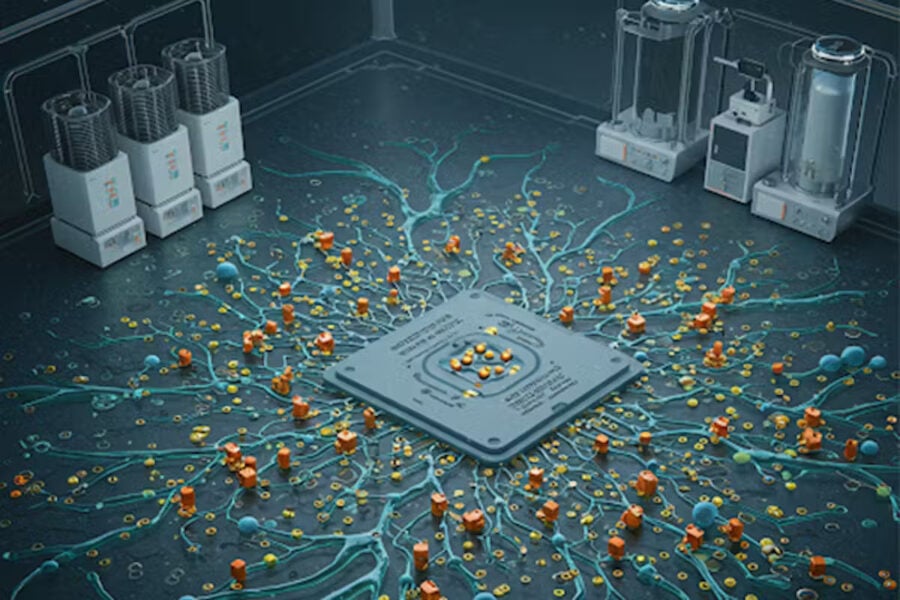The worlds of quantum mechanics and neural networks have collided in a new system that’s setting benchmarks for solving previously intractable optimization problems. A multi-university team led by Shantanu Chakrabartty at Washington University in St. Louis has introduced NeuroSA, a neuromorphic architecture that leverages quantum tunneling mechanisms to reliably discover optimal solutions to complex mathematical puzzles.
Published March 31 in Nature Communications, NeuroSA represents a significant leap forward in optimization technology with immediate applications ranging from logistics to drug development. While typical neural systems often get trapped in suboptimal solutions, NeuroSA offers something remarkable: a mathematical guarantee of finding the absolute best answer if given sufficient time.
“We’re looking for ways to solve problems better than computers modeled on human learning have done before,” said Chakrabartty, the Clifford W. Murphy Professor and vice dean for research at WashU. “NeuroSA is designed to solve the ‘discovery’ problem, the hardest problem in machine learning, where the goal is to discover new and unknown solutions.”
The system’s core innovation lies in its use of Fowler-Nordheim (FN) annealers—components that employ quantum mechanical tunneling principles to methodically explore solution spaces. This approach allows NeuroSA to escape local minimums that trap conventional optimizers.
When tested against industry-standard Maximum Cut problems—mathematical challenges central to everything from circuit design to investment portfolio optimization—NeuroSA consistently found solutions within 99% of the current state-of-the-art. More impressively, when tackling Maximum Independent Set problems, it frequently surpassed existing benchmarks altogether.
For investors tracking the computational hardware space, NeuroSA sits at a compelling intersection of quantum and neuromorphic computing—two fields attracting substantial venture capital. Unlike full quantum computers that require extreme cooling, NeuroSA’s hybrid approach can run on existing neuromorphic hardware platforms like SpiNNaker2.
The system’s energy consumption profiles, particularly when implemented on the SpiNNaker2 platform, suggest substantial efficiency gains over traditional CPU-based approaches—a critical factor as computing energy demands face increasing scrutiny.
“That critical bridge between neuro and quantum is what makes NeuroSA so powerful and what allows us to guarantee we’ll find a solution if given enough time,” Chakrabartty explained.
This mathematical guarantee becomes particularly valuable in optimization scenarios requiring extended processing times, from days to weeks, where certainty about eventually finding the optimal solution justifies the computational investment.
The breakthrough emerged from the Telluride Neuromorphic and Cognition Engineering workshop, with first author Zihao Chen, a graduate student at Washington University in St. Louis, leading implementation efforts.
For commercial applications, supply chain optimization represents an immediate target. Modern logistics networks contain millions of variables and constraints that conventional solvers struggle to handle efficiently. Drug discovery presents another promising application area, with NeuroSA potentially exploring protein folding configurations to identify novel therapeutic compounds.
The architecture’s ability to consistently approach optimal solutions without requiring problem-specific tuning marks a significant advantage over competing approaches. Traditional optimization systems typically require extensive parameter adjustments for each new problem type—a time-consuming process that NeuroSA largely eliminates.
From a technical perspective, NeuroSA’s architecture maps the mathematical properties of simulated annealing—a well-established optimization technique—onto a network of spiking neurons. This mapping creates a “functional isomorphism” that preserves the theoretical guarantees of the original algorithm while leveraging the massive parallelism of neuromorphic hardware.
Though impressive, the system isn’t without limitations. For maximally difficult problems, finding perfect solutions remains computationally expensive, with time requirements still scaling exponentially. However, NeuroSA’s ability to reliably approach near-optimal solutions quickly before continuing its search for perfection presents a pragmatic compromise for many real-world applications.
This research was supported by multiple funding sources including the U.S. National Science Foundation, Germany’s Federal Ministry of Education and Research, and the U.S. Department of Energy.
The commercial landscape surrounding this innovation includes patent protections for the Fowler-Nordheim dynamical systems managed by Washington University in St. Louis, while the SpiNNaker2 platform is developed by SpiNNcloud Systems, with which some co-authors maintain financial interests.
As computational demands continue to outpace conventional hardware capabilities, NeuroSA represents a promising pathway toward more efficient problem-solving—one that might just redefine what we consider mathematically possible.
Discover more from NeuroEdge
Subscribe to get the latest posts sent to your email.

